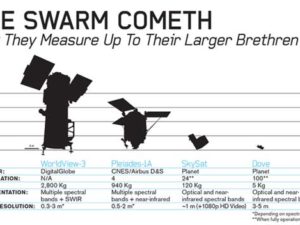
John M. Palatiello
President
John M. Palatiello & Associates, Inc.
Reston, Va.
www.jmpa.us
Legislation in congress has exposed a chasm in the geospatial community that could jeopardize chances to reform and improve the coordination and use of geospatial data.
Earlier this year, Senator Orrin Hatch (R-UT) introduced the Geospatial Data Act S. 1253, while a companion bill, H.R. 3522 was offered in the House by Representative Bruce Westerman (R-AR). Each was joined by bipartisan cosponsors.
According to an analysis by the Congressional Research Service (CRS) of the Library of Congress, the bills are intended for “the development, implementation, and review of policies, practices, and standards relating to geospatial data” and to “ensure that geospatial data (National Spatial Data Infrastructure, or NSDI) from multiple sources is available and easily integrated to enhance the understanding of the physical and cultural world.”
Provisions in the legislation seek to improve the governance of geospatial activities among federal agencies, as well as these entities’ relationships with state and local government, universities, and the private sector. Transparency and accountability provisions affecting the Federal Geographic Data Committee (FGDC) and the National Geospatial Advisory Committee (NGAC) are also included. Most significant is a clause in the bill that designates the Director of the Office of Management and Budget as Chairperson of the FGDC, a position currently held by the Secretary of the Interior and usually delegated to a lower-level official.
“The benefits of geospatial technology are truly untold. Our federal agencies use geospatial data, but often different agencies acquire duplicative information and waste precious taxpayer resources in the process,” Rep. Westerman said upon introducing his legislation. “This bill will save money, improve information accuracy, and provide a more modern system for collecting and sharing geospatial data.”
“The uses and applications for geospatial technology are immense and constantly growing,” Senator Hatch said. “The process in which the federal government collects geospatial data currently wastes vast amounts of taxpayer dollars and fails to provide the most accurate information. The GDA will provide the tools to create a more robust and modern system of maps and digital data with a budget that avoids redundant expenditures. We need to optimize the method in which we collect geospatial data to advance the technology for states, counties, and citizens around the nation.”
The Government Accountability Office (GAO) found without management improvements, that “the vision of improving the coordination of geospatial information and reducing duplicative investments will not be fully realized.” It went on to warn, “until there is effective coordination across the National Spatial Data Infrastructure, there will continue to be duplicative efforts to obtain and maintain these data at every level of government.”
Unlike the Map It Once, Use It Many Times Act, introduced in 2013 by Rep. Doug Lamborn (R-CO) (H.R. 1604, 113th Congress), the Geospatial Data Act does not address several other issues related to the federal government’s conduct of geospatial activities. Among these is development of a coordinated research and development agenda, the use of prison labor to provide data conversion and application services, sending work to offshore operators, or the need for a cadastre of land owned by the federal government. Nor does the Geospatial Data Act provide for any consolidation or reorganization of the more than 40 federal agencies with geospatial activities.
An earlier version of the Geospatial Data Act, (S. 740 and H.R. 6294) was introduced in the 114th Congress, in 2015, but no action was taken due to a lack of consensus within the geospatial community.
The current bills, S. 1253 and H.R. 3522, include revisions to address concerns raised on the previous proposals. The bills now recognize the important role the private sector plays in geospatial activities. Procurement, or contracting with the private sector, is inherent to the Geospatial Data Act and its goal of making the NSDI a success. The revised legislation addresses a variety of challenges, components and stakeholders in geospatial data and the NSDI, both governmental (federal, state and local) and the private sector. Provisions that assure quality in the procurement of the collection and acquisition of geospatial data were added to achieve the overall goals and objectives of the legislation. As introduced, S. 1253 and H.R. 3522 provide that the government should not duplicate or compete with the private sector in the performance of commercially available geospatial services, but rather should utilize the free enterprise system to the maximum extent possible.
The bill also requires contracting for such geospatial data services to use the competitive process based on demonstrated competence and qualifications of competing firms, rather than contracting awards to the lowest bidder. Such quality is essential to the success of government programs and activities that are dependent on reliable, accurate, and professionally acquired data and services. Moreover, the bills include a provision to preserve and comply with existing state law for licensing of professionals in surveying that protect public health, safety and welfare.
Organizations including the American Society of Civil Engineers (ASCE), the National Society of Professional Surveyors (NSPS), and MAPPS (An Association of Photogrammetry, Mapping, and Geospatial Firms) support the Geospatial Data Act as introduced and are resisting efforts by other organizations to weaken these important provisions. These groups support the private sector utilization, contracting and licensing provisions in the bill, noting in statements that they “serve the public interest, improve the geospatial activities and move the NSDI closer to a reality in service to the Nation and its citizens.”
In November of 2017, Sen. Hatch and Rep. Westerman introduced new bills, S. 2128 and H.R. 4395, that are similar to their original 2015 proposals, S. 740 and H.R. 6294. The most current bills do not have the private sector utilization, primacy of state law, or qualifications-based contracting provisions. They have the support of the American Association of Geographers (AAG).
The National States Geographic Information Council (NSGIC) has supported the bills introduced earlier this year, as well as the current proposals.
“Since the federal government does not manage the licensing of surveyors or the resulting enforcement, then there must be recognition of state licensing laws at the federal level so any federal regulations provide the public with the avenue to understand where their protection of health, safety and welfare resides,” said Patrick A. Smith, RPLS, Vice President, Surveying and Mapping LLC (SAM) and Chairman of the NSPS Government Affairs Committee.
“Too many GIS databases are built without an accurate initial base. If the initial data is not more accurate than the resulting application data, then the resultant compounding error in positions could signi cantly impact public health, safety and welfare in applications,” Smith said.
According to Marvin Miller, PLS, RPP, CP, PPS, SP, a geospatial professional based in Zimmerman, Minn. and chair of the MAPPS forum on government and university competition, “Federally initiated and funded geospatial projects and their respective data deliverables can and do make their way into state/county/municipal agencies that may then use such data as authoritative documents without being prepared under the responsible charge of a state-licensed professional. Recognition of state licensing laws for geospatial projects by the federal government would serve to not only expand the official use of the data by state and local agencies, but also to encourage and promote regional funding participation.”
“The government should not be engaged in activities that can be performed by the private sector,” Miller said. “That is supported by numerous independent studies conducted by the government.”
“The bill also requires contracting for such geospatial data services to use the competitive process based on demonstrated competence and qualifications of competing firms, rather than contracting awards to the lowest bidder. Such quality is essential to the success of government programs and activities that are dependent on reliable, accurate, and professionally acquired data and services.”
In fact, as early as 1973 an OMB (White House Office of Management and Budget) study found that mapping is a commercial activity and recommended that more of it be contracted. The Report of the Federal Mapping Task Force on Mapping, Charting, Geodesy and Surveying, OMB, July 1973 said, “Private cartographic contract capability is not being used sufficiently. We found this capacity to be broad and varied and capable of rendering skilled support to federal MC&G (mapping, charting and geodesy) programs. Contract capability is a viable management alternative, and using it would be consistent with the President’s desire to limit the size of the federal payroll. Its use should be encouraged in lieu of continued in-house build-up.”
Duplication can take two forms. Some data are collected multiple times by federal, state, and local government, resulting in duplication in effort and resources; and government also duplicates and at times competes with the data and services of private geospatial firms. S. 1253 and H.R. 3522 establish that the government will not compete with private enterprise, but rather will utilize the private sector to the maximum extent possible.
Consistent with current federal law and the code in most states, the bill assures that contracts will be awarded to qualified and competent firms, subject to negotiation of a price that is fair and reasonable to the government. Moreover, the provision to protect the primacy of state law will prevent the unintended consequence of the federal government condoning unlicensed practice that jeopardizes public health, safety, and welfare.
“As one small step toward more effective and efficient government, the Geospatial Data Act must address all forms of duplication as well as preserve and uphold professionalism in the geospatial field by recognizing licensure and qualifications in government activities and the procurement process.”
Reforming federal geospatial activities may not earn the same attention as health care, immigration, or tax reform, but this duplication and lack of coordination is illustrative of the swamp in Washington, D.C. that needs to be drained. There are dedicated federal employees who do the best they can while trapped in an inefficient system. As one small step toward more effective and efficient government, the Geospatial Data Act must address all forms of duplication as well as preserve and uphold professionalism in the geospatial field by recognizing licensure and qualifications in government activities and the procurement process.
It is commonly recognized that Congress is loath to get in the middle of disputes with a specific industry or profession. Until there is “peace in the valley,” as one state lawmaker noted, legislation like the Geospatial Data Act is not likely to be acted upon in Congress.



